Project of a light tank UDES 15 / 16 (Sweden)
Projects UDES (Underlagsgrupp Direkt Eld Stridsfordon - "Ground combat vehicle firing direct fire") with the numbers "15" and "16" were supposed to be a new step in the existing program, which started a few years ago. Recall that the first development of its family was the UDES 03 project, which was actually a further development of the serial Strv 103 tank. Based on the experience of this project, it was decided to abandon the reckless scheme and design tanks with a traditional layout of the fighting compartment and weapons - such a project was designated as UDES 14.
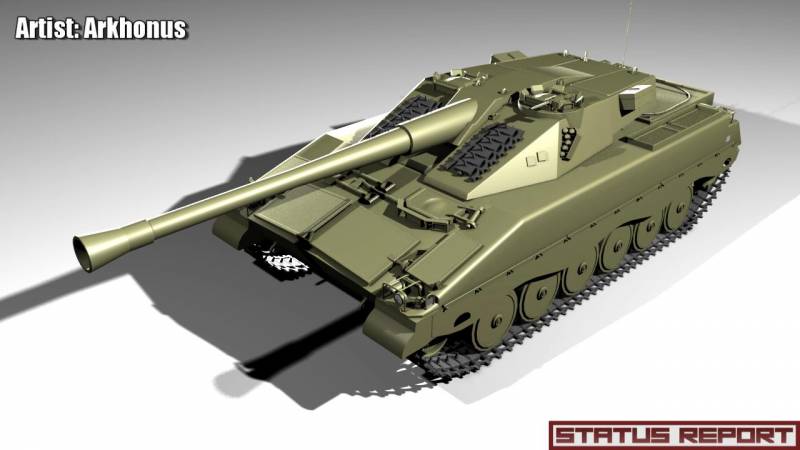
Modern reconstruction of the appearance of the tank UDES 15 / 16. Figure Ritastatusreport.blogspot.ru
As part of the UDES 14 project, the organizations participating in the work created and presented to the military a large number of versions of equipment that had both similarities and differences. From the presented set, the customer chose two projects that differed from others in relatively high performance and relative simplicity. The contractors were to continue their development, and in the future it was planned to compare the two developments and draw conclusions. The most successful combat vehicle had certain chances to go into series and enter service.
The overall coordination of the work on the UDES project was carried out by the FMV organization, which was responsible for the development and purchase of a variety of materiel. In addition to determining the requirements and ways of developing technology, within the framework of the UDES program, the FMV organization was engaged in the creation of its own projects. Bofors and Hägglunds were involved in the work on the UDES 14, UDES 15 and UDES 16 projects.
Based on the analysis of the preliminary design of the UDES 14 tank, the military chose two proposed projects. Bofors was to continue work on the UDES 14-2 project, while Hägglunds was required to develop the UDES 14E theme. To avoid confusion, the projects were given new designations. The development of "Bofors" was named UDES 15, and the competing project was renamed UDES 16. Despite the name change, a serious revision of the projects was not expected. Contracting firms had to work out various nuances of projects, taking into account the possible construction of experimental equipment. The main features of promising tanks, with which they were able to win the previous "competition", should have been left unchanged.
All preliminary projects of the two companies were created in accordance with the general terms of reference, which is why some of the proposed developments had a noticeable similarity. It is for this reason, and also in connection with the specific views of the customer, the UDES 15 and UDES 16 tanks were similar to each other both in their design and in their intended appearance. At the same time, however, the same design problems were solved in different ways, which should have led to the presence of a mass of noticeable differences.
In accordance with the technical assignment from FMV, both tanks of new types should have a combat weight at the level of 25-27 t and a specific power of at least 20 hp. per ton, which required a diesel power unit with a capacity of about 500-550 hp The war machine had to be equipped with counter-booking, able to protect it from the maximum possible number of threats. As the main weapons considered 105-mm rifled tank gun, housed in a full-fledged swivel turret. The gun could be mated with an automatic loader or work with the loader. The crew of the tank included three or four people. Both new projects had similar features.
In 1974, for some time, two projects of light tanks were developed in parallel. A little later, FMV specialists decided that such a development of the project does not make sense. Two commercial companies created their own versions of promising technology, which had a minimum number of differences. As a result, the continuation of the separate development of the two projects was considered inappropriate. All subsequent work was to be carried out by two contractors jointly, within the framework of a single project. This version of the tank, based on two existing developments, was designated UDES 15/16.
Soon after the merger of the two projects, Bofors and Hägglunds formed the look of a promising tank, received customer approval and continued to work on the development of a common development. In connection with the merger of projects, the technical requirements did not change. The customer still wanted to get a mobile light armored vehicle with relatively powerful weapons. At the same time, however, proposals were received to introduce into the project some new ideas and solutions aimed at increasing combat effectiveness.
Available information suggests that the UDES 15/16 project should have used some ready-made elements borrowed from previous developments. In addition, some of the systems and devices could be the processing of previously designed products, modified in accordance with new experience or updated requirements. Finally, some structural elements were completely redeveloped in order to correct the identified shortcomings or improve their design. As a result, the UDES 15/16 tank had to have certain features of the UDES 15 and UDES 16 vehicles, as well as some new features of its own.
In accordance with the new project, the promising UDES 15/16 light tank was supposed to retain the general appearance of its predecessor vehicles, as well as use a proven layout. An armored hull with a relatively high level of protection was proposed. The upper frontal sheet of medium thickness had to be placed at a slight angle to the horizontal, which increased its protection performance accordingly. The lower frontal part of the hull was assembled from several smaller sheets. Above the vertical lower part of the sides, which has fasteners for undercarriage elements, it was planned to place relatively large fender niches. These devices could receive low vertical sides and a sloping roof connected to a horizontal turret hull sheet. Behind the latter, a sloping roof sheet could be placed.
The project envisaged the use of the layout already mastered in the UDES program. The engine and transmission were to be in front of the hull and provide additional protection for the crew. Behind the engine, at the left side, placed the office of management with the workplace of the driver. The central compartment was given under the fighting compartment. In the free volumes of the stern it was possible to arrange additional stowage of ammunition or other necessary devices.
On the pursuit of the corps, it was proposed to place a full-fledged gun turret of a characteristic appearance. It was planned to equip it with powerful frontal armor, placed at a large angle to the vertical. The project also provided for the presence of several zygomatic sheets, vertical sides of small width and a developed aft niche. The protection of the breech and recoil devices of the gun was carried out using a wedge-shaped mask, which protrudes significantly in front of the frontal sheet. The maximum thickness of the turret armor reached 160 mm on the zygomatic sheets. The sloping forehead was thinner - 125 mm.
As part of the project, two options for placing the gun were considered. The first was traditional: the gun could swing on trunnions, while the devices associated with it were placed permanently. The second option involved the use of the so-called. carriage layout. In this case, the breech and automatic loader were in a rectangular armored case of large elongation, placed in the corresponding cavity along the tower. An armored box with a mechanized ammo rack was attached to the back of such a body. With this arrangement, a large unit, including a gun, its body and aft niche of the tower, could swing in a vertical plane. Regardless of the design of the gun mount, the vertical aiming angles had to vary from -5 ° to + 20 °. To increase the possible descent angles, it was planned to use a controlled hydraulic suspension.
Both options for the placement of weapons had pros and cons. The first was easier, but allowed to reload the gun only at a given position of the barrel. The second layout simplified recharging, but had a negative effect on the overall complexity of the design. Apparently, the final choice was planned to be made later, perhaps even after testing the prototypes of the combat compartment.
The main weapon of the promising UDES 15/16 tank was to be a 105 mm rifled gun. The gun was supposed to be equipped with a muzzle brake and a means of blowing the barrel with compressed gas, the use of an ejector was not supposed. An automatic loader was placed next to the breech of the gun. The ammunition was to be stored in a mechanized stowage of the aft niche of the tower. The shells were placed in two horizontal rows of ten pieces each. Automation had to independently select the required type of projectile and feed it to the ramming line. In the future, it was planned to develop a new gun mount with a 120 mm gun, but the project did not reach this stage.
The dimensions of the existing aft niche made it possible to accommodate ammunition in the form of 20 unitary shells. In the event of a long battle in the "single" project, they proposed an interesting storage system for the second stage of ammunition. It was proposed to make the aft niche of the tower detachable and consisting of two large side units, between which an elongated central element with automatic loader parts was placed. It was planned to mount a swinging boom with drives and fasteners on the aft hull sheet. It was proposed to carry two additional boxes with ammunition.
After the ready-to-use ammunition was used up, the crew had to drop empty stern niche boxes and deploy the tower to the neutral position. After that, the aft boom could rise and install a new niche with the stacks on the tower. The ability to transport four drop corps allowed to bring the total tank ammunition to 40 shells, as required by the technical task.
To obtain the required mobility, the UDES 15/16 tank had to be equipped with a diesel engine with an output of at least 500 hp. The engine was placed in front of the hull next to the transmission. The chassis was based on six road wheels on each side. It was proposed to equip the rollers with an individual hydraulic suspension with the ability to adjust the pressure in the cylinders. Due to this, it was possible to change the characteristics of the suspension, as well as to transfer the tank to the required position. So, with the help of an adjustable suspension, it was possible to lower the bow of the hull, increasing the allowable angles of descent of the gun to -10 °.
The use of an automatic loader made it possible to reduce the crew of an armored vehicle to three people. The driver was placed in the case; the places of the commander and gunner were in the tower. All crew members had their own hatches in the roof of the hull and turret. Optical instruments were located next to the hatches. The commander, who was to the left of the gun, had a low turret with instruments that provide all-round visibility.
Before building a full-fledged prototype, it was decided to collect a number of mock-ups and test some ideas on experimental equipment. It was to test the new turret that a prototype known as the UDES 15/16 Tornrigg or UDES 15/16 TR was built. The chassis of the latest Ikv 91 light tank was taken as the basis for this vehicle, on which, instead of the standard turret, a mock-up of the fighting compartment, developed as part of a new project, was installed. The resulting armored vehicle, in terms of a number of its characteristics, corresponded to the UDES 15/16 project tank, although it had some differences. In particular, there was no controlled suspension, which increased the sector of fire of the main gun. In addition, the stern boom and boxes of additional ammunition were not installed on the preliminary prototype.
The experimental machine UDES 15/16 TR was put to the test, during which some features of the advanced technology were established. First of all, experts were interested in the behavior of the new tower when moving through various areas. Tests of the prototype showed that the new design meets the requirements. This made it possible to continue work and move on to the construction of new products and prototypes.
In the same 1974, contractors jointly built the first and, as it turned out later, the last model of a promising tank. The construction of timber, plywood and other similar materials demonstrated the appearance of a promising machine, as well as the main features of its design. When assembling the layout, the newest version of the UDES 15/16 project was used. In order to somewhat simplify and speed up the assembly of the layout, and also due to the lack of need for such products, the wooden "tank" did not receive a full-fledged chassis. Instead, plywood boxes with the corresponding pattern on the side walls were used. At the same time, the layout received normal hatches with imitation of optical instruments.
The wooden mock-up of a promising tank was intended for study by army specialists from the FMV department. The military got acquainted with the final shape of the UDES 15/16 armored vehicle and made their decision. For one reason or another, it was decided to abandon further work on the project. There is no exact information about the possible reasons for such a refusal. Perhaps the military was not satisfied with the excessive complexity of the project or the high cost of finished equipment. In addition, ambiguous characteristics could be considered a serious problem for the new tank. With a sufficiently high mobility, the vehicle was distinguished by not very powerful armor, which could negatively affect its survivability in combat conditions.
The UDES 15/16 project was closed in favor of other developments of a similar purpose. At that time, the Swedish industry, fulfilling FMV orders, developed more and more new projects of advanced armored vehicles. Some of these developments reached the stage of building mock-ups or prototypes, while others remained only on paper, although they contributed to the emergence of new projects. The promising UDES 15/16 tank was not built or tested, but it had some influence on subsequent work. In the same 1974, the creation of several other machines of a similar purpose began, in which it was planned to use certain developments on a closed "intermediate" project.
On the materials of the sites:
http://ointres.se/
http://tanks-encyclopedia.com/
http://ritastatusreport.blogspot.ru/
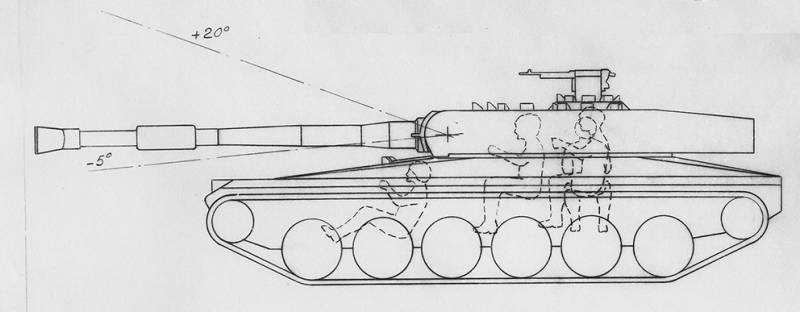
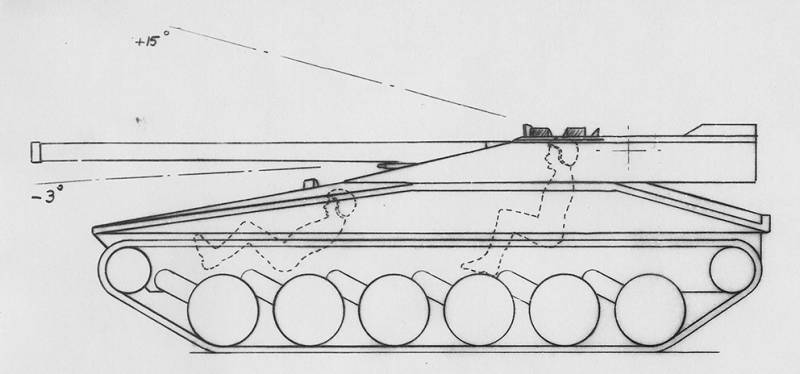
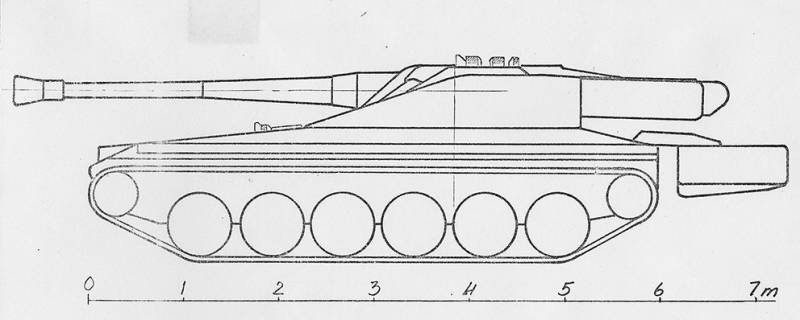
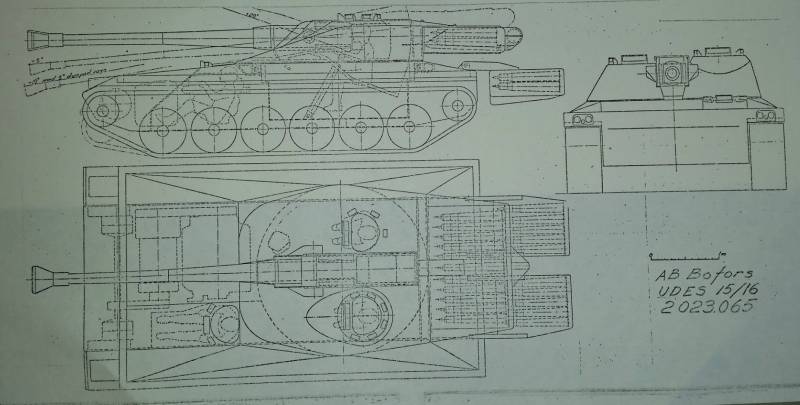
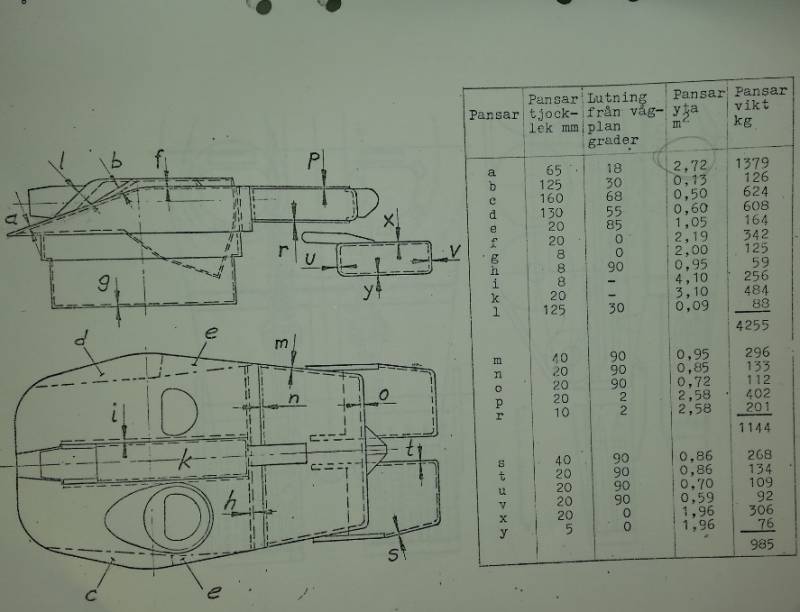
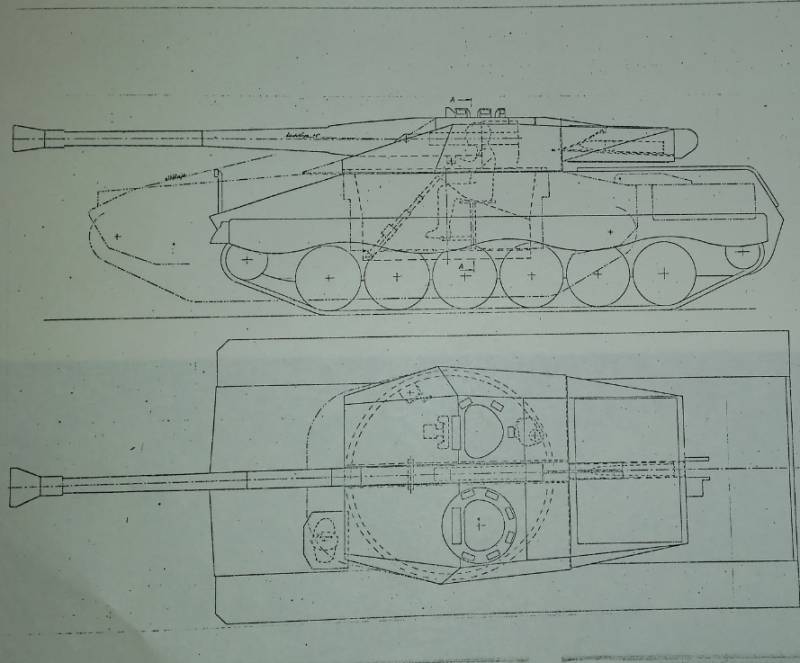
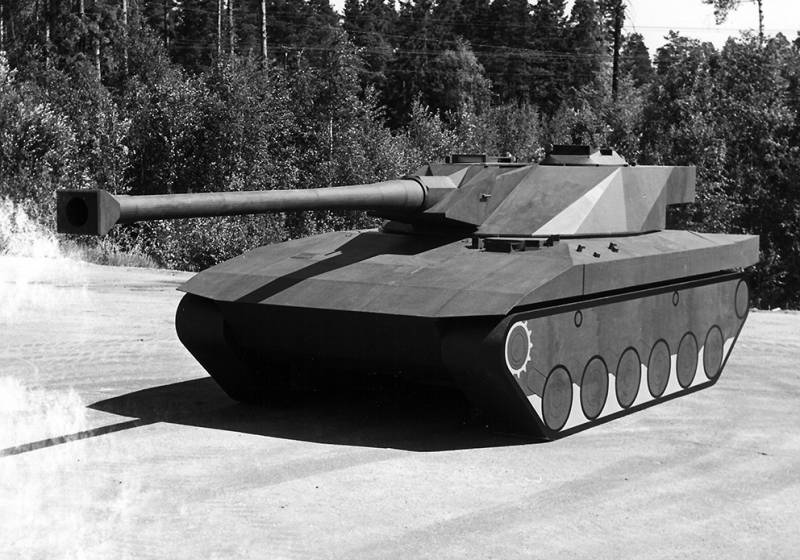
Information